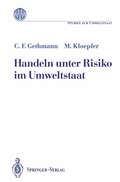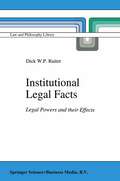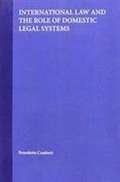- Table View
- List View
Europäisches Wirtschaftsrecht und Europäische Integration: 363. Sitzung am 17. Februar 1993 in Düsseldorf (Rheinisch-Westfälische Akademie der Wissenschaften #325)
by Bernhard GrossfeldWir stehen an einem Datum von größter Bedeutung für uns, für unsere Kinder: Am 1. Januar 1993 begann der Europäische Binnenmarkt. Er umfaßt "einen Raum ohne Binnengrenzen, in dem der freie Verkehr von Waren, Per sonen, Dienstleistungen und Kapital gemäß den Bestimmungen dieses Ver trages gewährleistet ist. " (Art. 8 a Abs. 2 EWGV) Dennoch wird die Europäische Integration kritisiert. Seit dem Vertrag von Maastricht über die Europäische Union und die Europäische Währungsunion wachsen Zweifel an einer europäischen Zukunft. Es geht nicht nur um die Sta bilität der Währung, sondern darum, daß der Europäischen Gemeinschaft das rechte Verhältnis zum Bürger fehle, daß ihr zuviel Macht zuwachse, daß ihre Be ziehung zu den europäischen Staaten und Regionen dem Subsidiaritätsprinzip ent gleite. Dazu wird demnächst das Bundesverfassungsgericht entscheiden. I Mit diesen großen Fragen der europäischen Politik möchte ich mich nicht befas sen. Der Jurist lernt je länger je mehr, daß er für die eher kleinen Angelegenheiten zuständig ist und sich die politischen Ströme seinem Einfluß entziehen; in ihnen schafft sich das Leben eine Ordnung ohne den Juristen. Aber sein "kleines" Arbeitsfeld ist doch wiederum so groß, daß es ernst zu nehmen ist. Wir werden sehen, daß auch die handwerklich-künstlerische juristische Technik die europäi sche Integration vorantreibt. Der Laie erlebt das Recht in der umfassenden Wirkung von der Wiege bis zur Bahre kaum.
Europarecht und nationale Umweltpolitik: Nationale Abweichungsmöglichkeiten von der gemeinschaftlichen Rechtsangleichung und Ausnahmen vom Grundsatz des freien Warenverkehrs am Beispiel des Umweltschutzrechtes (Wirtschafts- und verwaltungsrechtliche Studien #7)
by Ursula HoffertDas Buch analysiert die Typen von Rechtsakten in der EG. Es zeigt die Möglichkeit, vom EG-Recht abweichende, nationale Rechtsvorschriften zu erlassen (insbesondere im Umweltschutzrecht). Weiters wird das Spannungsverhältnis zwischen dem Grundsatz des freien Warenverkehrs und nationalen Schutzbestrebungen in der innerstaatlichen Gesundheits- und Umweltpolitik beleuchtet. Es folgt die Darstellung des durch die EEA normierten Kapitels "Umweltpolitik" und die im primären Gemeinschaftsrecht festgeschriebene Abweichungsmöglichkeit der Mitgliedstaaten. Im Abschluß werden mögliche Auswirkungen der in Maastricht vereinbarten Vertragsänderungen diskutiert.
European Community Law (Palgrave Professional Masters)
by Josephine ShawAn introduction for students commencing the study of Community law, who want an account of the fundamental constitutional principles, and basic substantive law of the European Community. It should also be of interest to lawyers and those who want to know about the impact of Community law on the UK.
Fachinformation Online: Ein Überblick über Online-Datenbanken unter besonderer Berücksichtigung von Wirtschaftsinformationen
by Josef L. StaudFacing Evil
by John KekesArguing that the prevalence of evil presents a fundamental problem for our secular sensibility, John Kekes develops a conception of character-morality as a response. He shows that the main sources of evil are habitual, unchosen actions produced by our character defects and that we can increase our control over the evil we cause by cultivating a reflective temper.
Family Law (Palgrave Professional Masters (Law))
by Kate StandleyThis textbook provides case material, sections on the unmarried family and protection against violence, along with the more traditional coverage of marriage and divorce, and the area of children and the law. It should be of interest to students of law and those in social and caring professions.
The Fate of Law (The Amherst Series In Law, Jurisprudence, And Social Thought)
by Austin Sarat Thomas R. KearnsAssesses the impact of intellectual and political movements of the late twentieth century on law and legal theory
Foreshadows of the Law: Supreme Court Dissents and Constitutional Development
by Bloomsbury PublishingThe Supreme Court has final authority in determining what the Constitution means. The Court's findings have not, however, always been final. Lively focuses on several landmark dissenting opinions--resisted initially--later redefining the meaning of the Constitution. Each opinion arises from a rich historical context and involves constitutional issues of pointed significance. Vivid descriptions of some of the colorful personalities behind the opinions add appeal. Lively conveys the evolutionary and dynamic nature of the law demonstrating the relationship between present and past understanding of the Constitution. He describes the competitive nature of constitutional development and identifies the relevance of factors including subjective preference, values, vying theories, and ideologies.The role of the Court, is addressed as are the federal government's relationship to the states and their citizens; slavery; property rights; substantive due process; freedom of speech; and the right to be left alone. This is a clearly presented and highly instructive consideration of how the Constitution's interpretation has been fashioned over time with important insights relevant to today's Court and contemporary cases.
Free Press v. Fair Trial: Supreme Court Decisions Since 1807 (Non-ser.)
by Douglas S. CampbellThis volume takes a historical approach in analyzing all of the major United States Supreme Court cases relevant to the conflict between a free press and fair trial. Campbell's thorough analysis, which relates 30 primary cases to each other and to nearly 70 associated supporting cases, consists of five parts: (1) legal backgrounds; (2) immediate historical circumstances giving rise to the cases; (3) complete summaries of all court opinions, concurring opinions, and dissenting opinions, often using the Justices' own words; (4) the Court's ruling; and (5) analysis of the significance of the cases.
Freezing Assets: The USA and the Most Effective Economic Sanction (International Political Economy Ser.)
by Mahvash AlerassoolGesellschaft — Ethik — Risiko: Ergebnisse des Polyprojekt-Workshops vom 23. – 25. November 1992 (Monte Verita)
by H. Ruh H. SeilerGrundzüge des österreichischen Strafverfahrens (Springers Kurzlehrbücher der Rechtswissenschaft)
by Winfried PlatzgummerDas kürzlich beschlossene Strafprozeßänderungsgesetz 1993, BGBl. Nr. 526, hat eine Fülle von Neuerungen gebracht. Sie betreffen etwa, um nur die wichtigsten Punkte herauszugreifen, die Zuständig keit der Gerichte, die Stellung des UR und die Rechtsmittel in der Voruntersuchung, die Verteidigung, die Zeugenvernehmung und die Entschlagungsrechte, die Zwangsmittel, insbesondere das gesamte Haftrecht, die Protokollverlesung in der Hauptverhandlung, das Verfahren vor dem Einzelrichter und dem Bezirksrichter, die Rechtsmittel gegen das Urteil und die Rechtsbehelfe - kurz und gut, sie betreffen fast das gesamte Strafverfahren. Unter diesen Umständen war eine Neuauflage der Grundzüge unausweichlich. Sie wurde unter äußerstem Zeitdruck erstellt, um den Studenten möglichst schon für den Herbst wieder einen brauchbaren Studienbehelf zu bieten. Sollte es glücken, diesen Zeitplan ein zuhalten, so verdanke ich das dem Herrn Sektionschef Dr. Roland Miklau und dem Vorsitzenden des Justizausschusses, Herrn Abge ordneten Dr. Michael Graff, die mir den Text des Strafprozeßände rungsgesetzes liebenswürdigerweise noch vor seiner Kundmachung im Bundesgesetzblatt zur Verfügung gestellt haben. Literatur und Rechtsprechung sind bis einschließlich Mai 1993 berücksichtigt. Bei der Benützung des Schrifttums habe ich so wie bisher auf Einzelnachweise und Auseinandersetzungen verzichtet, um die Darstellung, ihrem Zweck entsprechend, möglichst kurz und bündig zu halten. Literaturhinweise sollen den Zugang zu weiter führenden Studien erleichtern. Manche Publikationen konnte ich dabei unterschlagen, weil sie durch die Gesetzgebung überholt sind.
Gun Control and the Constitution: The Courts, Congress, and the Second Amendment
by Robert J. CottrolFirst Published in 1993. This volume is a collection of legal and historical material of the second amendment that includes court cases and decisions, law review articles and gives a balanced view of both sides of the debate.
Gun Control and the Constitution: The Courts, Congress, and the Second Amendment
First Published in 1993. This volume is a collection of legal and historical material of the second amendment that includes court cases and decisions, law review articles and gives a balanced view of both sides of the debate.
Handeln unter Risiko im Umweltstaat (Ladenburger Kolleg Studien zum Umweltstaat)
by Carl F. Gethmann Michael KloepferDer Preis für Wohlstand und Funktionsfähigkeit der modernen Industriegesellschaft besteht in dem Eingehen von sozialen, technischen und ökologischen Risiken. Diese Risiken werden in der Bevölkerung unterschiedlich bewertet. Dabei unterscheidet sich häufig das subjektive Risikoempfinden von der objektiven Risikobewertung. Die hierzwischen entstehende Lücke klafft weit auseinander und erschwert eine rationale Diskussion über die Bewertung von Risiken. Um sie zu schließen, bedarf es einer vertiefenden Auseinandersetzung über die Methodik der Risikobewertung, zu der hier aus ethischer wie juristischer Sicht ein Beitrag geleistet werden soll. Wenn sich der Staat als Umweltstaat unter Berufung auf (tatsächliche oder vermeintliche) Risiken, die es einzudämmen gelte, neue Eingriffsbefugnisse in die Rechte seiner Bürger verschafft, wird staatliches Handeln unter Unsicherheit zu einem rechtsstaatlichen Problem, zu dessen Bewältigung der vorliegende Band beitragen soll.
A History of the Supreme Court
by the late Bernard SchwartzWhen the first Supreme Court convened in 1790, it was so ill-esteemed that its justices frequently resigned in favor of other pursuits. John Rutledge stepped down as Associate Justice to become a state judge in South Carolina; John Jay resigned as Chief Justice to run for Governor of New York; and Alexander Hamilton declined to replace Jay, pursuing a private law practice instead. As Bernard Schwartz shows in this landmark history, the Supreme Court has indeed travelled a long and interesting journey to its current preeminent place in American life. In A History of the Supreme Court, Schwartz provides the finest, most comprehensive one-volume narrative ever published of our highest court. With impeccable scholarship and a clear, engaging style, he tells the story of the justices and their jurisprudence--and the influence the Court has had on American politics and society. With a keen ability to explain complex legal issues for the nonspecialist, he takes us through both the great and the undistinguished Courts of our nation's history. He provides insight into our foremost justices, such as John Marshall (who established judicial review in Marbury v. Madison, an outstanding display of political calculation as well as fine jurisprudence), Roger Taney (whose legacy has been overshadowed by Dred Scott v. Sanford), Oliver Wendell Holmes, Louis Brandeis, Benjamin Cardozo, and others. He draws on evidence such as personal letters and interviews to show how the court has worked, weaving narrative details into deft discussions of the developments in constitutional law. Schwartz also examines the operations of the court: until 1935, it met in a small room under the Senate--so cramped that the judges had to put on their robes in full view of the spectators. But when the new building was finally opened, one justice called it "almost bombastically pretentious," and another asked, "What are we supposed to do, ride in on nine elephants?" He includes fascinating asides, on the debate in the first Court, for instance, over the use of English-style wigs and gowns (the decision: gowns, no wigs); and on the day Oliver Wendell Holmes announced his resignation--the same day that Earl Warren, as a California District Attorney, argued his first case before the Court. The author brings the story right up to the present day, offering balanced analyses of the pivotal Warren Court and the Rehnquist Court through 1992 (including, of course, the arrival of Clarence Thomas). In addition, he includes four special chapters on watershed cases: Dred Scott v. Sanford, Lochner v. New York, Brown v. Board of Education, and Roe v. Wade. Schwartz not only analyzes the impact of each of these epoch-making cases, he takes us behind the scenes, drawing on all available evidence to show how the justices debated the cases and how they settled on their opinions. Bernard Schwartz is one of the most highly regarded scholars of the Supreme Court, author of dozens of books on the law, and winner of the American Bar Association's Silver Gavel Award. In this remarkable account, he provides the definitive one-volume account of our nation's highest court.
Homicide: A Bibliography, Second Edition
by Bal K. Jerath Rajinder JerathHomicide represents the result of an exhaustive search of the world literature regarding homicide. More than 7,000 entries have been compiled from references selected from major indexes in libraries from outstanding universities, government agencies, and military posts; science libraries; law libraries; and the Library of Congress. Each entry features a one- or two-word annotation that indicates whether it is an article or a book, and all entries conform to the American Psychological Association stylebook guidelines. Key-word and author indexes provide quick access to works pertaining to particular subjects or by a certain author.
Homicide: A Bibliography, Second Edition
by Bal K. Jerath Rajinder JerathHomicide represents the result of an exhaustive search of the world literature regarding homicide. More than 7,000 entries have been compiled from references selected from major indexes in libraries from outstanding universities, government agencies, and military posts; science libraries; law libraries; and the Library of Congress. Each entry features a one- or two-word annotation that indicates whether it is an article or a book, and all entries conform to the American Psychological Association stylebook guidelines. Key-word and author indexes provide quick access to works pertaining to particular subjects or by a certain author.
In the Name of Science: Issues in Responsible Animal Experimentation
by F. Barbara OrlansFew arguments in biomedical experimentation have stirred such heated debate in recent years as those raised by animal research. In this comprehensive analysis of the social, political, and ethical conflicts surrounding the use of animals in scientific experiments, Barbara Orlans judges both ends of the spectrum in this debate -- unconditional approval or rejection of animal experimentation -- to be untenable. Instead of arguing for either view, she thoughtfully explores the ground between the extremes, and convincingly makes the case for public policy reforms that serve to improve the welfare of laboratory animals without jeopardizing scientific endeavor. This book presents controversial issues in a balanced manner based on careful historical analysis and original research. Different mechanisms of oversight for animal experiments are compared and those that have worked well are identified. This compelling work will be of interest to biomedical scientists, ethicists, animal welfare advocates and other readers concerned with this critical issue.
Informed Consent: Patient Autonomy and Physician Beneficence within Clinical Medicine (Clinical Medical Ethics #4)
by S. WearSubstantial efforts have recently been made to reform the physician-patient relationship, particularly toward replacing the `silent world of doctor and patient' with informed patient participation in medical decision-making. This 'new ethos of patient autonomy' has especially insisted on the routine provision of informed consent for all medical interventions. Stronly supported by most bioethicists and the law, as well as more popular writings and expectations, it still seems clear that informed consent has, at best, been received in a lukewarm fashion by most clinicians, many simply rejecting what they commonly refer to as the `myth of informed consent'. The purpose of this book is to defuse this seemingly intractable controversy by offering an efficient and effective operational model of informed consent. This goal is pursued first by reviewing and evaluating, in detail, the agendas, arguments, and supporting materials of its proponents and detractors. A comprehensive review of empirical studies of informed consent is provided, as well as a detailed reflection on the common clinician experience with attempts at informed consent and the exercise of autonomy by patients. In the end, informed consent is recast as a management tool for pursuing clinically and ethically important goods and values that any clinician should see as meriting pursuit. Concurrently, the model incorporates a flexible, anticipatory approach that recognizes that no static, generic ritual can legitimately pursue the quite variable goods and values that may be at stake with different patients in different situations. Finally, efficiency of provision is addressed by not pursuing the unattainable and ancillary. Throughout, the traditional principle of beneficence is appealed to toward articulating an operational model of informed consent as an intervention that is likely to change outcomes at the bedside for the better.
Institutional Legal Facts: Legal Powers and their Effects (Law and Philosophy Library #18)
by D.W. RuiterLaw is traditionally conceived as consisting of norms of conduct and power-conferring norms. This conception, however, is unable to account for a variety of elements of modern legal systems that differ significantly from the classical notions. This book concerns the problem of which results of human activity can obtain legal validity. The author makes use of recent findings in speech act theory, especially John R. Searle and Daniel Vanderveken's illocutionary logic. He sets out a theory of legal norms conceived as institutional legal facts resulting from performances of speech acts specified in power-conferring norms. The theory provides a classification of acts-in-the-law and of legal norms resulting from performances of these. Finally, the transition is made from institutional legal facts to legal institutions. The book is a contribution to the institutional theory of law as developed by N. MacCormick and O. Weinberger.
International Law And The Role Of Domestic Legal Systems (PDF)
by Benedetto Conforti Rene Provost Shauna Van PraaghThis book is an updated version of the General Course on public international law given by the author in French at the Hague Academy of International Law in 1988. It provides an outline of the Law of Nations in a perspective that focuses on its application and development through domestic courts and other legal actors. It is based on the idea that international law is no longer the exclusive province of diplomats but must evolve under the guidance of all State organs charged with applying the law.






















